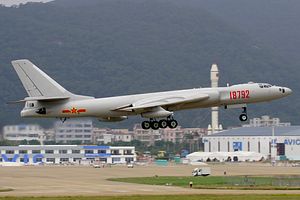The People’s Liberation Army Air Force (PLAAF) sent four Xian H-6K long-range bombers, one Shaanxi Y-8 electronic countermeasures aircraft, and two Tupolev Tu-154MD electronic intelligence aircraft through international airspace between the Japanese islands of Okinawa and Miyako in the East China Sea this weekend, the Japan Ministry of Defense (MoD) reports in two separate statements.
On November 18, a PLAAF Shaanxi Y-8 electronic countermeasures aircraft flew through the strategically important Miyako Strait, located between the Japanese islands of Miyako and Okinawa, and a principal entryway for the People’s Liberation Army Navy (PLAN) into the Pacific Ocean.
The following day, November 19, four Xian H-6K long-range bombers, one Tupolev Tu-154MD electronic intelligence aircraft, and a Y-8 flew through the strait as part of what China has called continuous “regular” exercises in the area. The Japanese MoD says that Japanese airspace was not violated.
The Japan Air Self-Defense Force (JASDF) scrambled Mitsubishi F-15J all-weather air superiority fighters in response. The JASDF stood up a new F-15J air wing on Okinawa in early 2016 in response to increased Chinese military activity in the East China Sea. The deployment of the new air-wing has doubled the number of JASDF fighter jets on Okinawa from 20 to 40.
In February of this year, the JASDF also announced that it has doubled the number of fighter jets dispatched to intercept foreign military aircraft approaching Japanese airspace from two to four.
“The doubling of aircraft used for scrambles against foreign military aircraft will put additional pressure on an already overstretched JASDF,” I explained elsewhere. “Unless Japan steps up its procurement process and accelerates the introduction of new aircraft (e.g. the F-35), the JASDF will likely face a shortage of fighter aircraft in the 2020s.”
The flight of the PLAAF aircraft was the first through the passageway since July when six H-6K bombers flew through the Miyako Strait and back. The PLAAF conducted similar exercises in the East China Sea, including flying through the Miyako Strait, in September, November, and December 2016.In all three instances the JASDF dispatched fighter jets.
During the first half of fiscal year 2017, the JASDF had to scramble its jets a total of 287 times, down 120 times from the same time period in 2016, according to the Japanese MoD.“ [T]he JASDF scrambled its fighter jets 1,168 times in fiscal year 2016, up from 873 in 2015,” I explained. The JASDF especially remains concerned about the PLAAFs bomber presence in the East China Sea.
Armed with up to seven YJ-12 supersonic anti-ship missiles — six on wing pylons plus one in the bomb bay — or nuclear/non-nuclear CJ-10A (KD-20) land-attack cruise missiles, the H-6K — a Chinese derivative of the Soviet-era Tupolov Tu-16 twin-engined jet strategic bomber — can carry a payload of up to 12 tons.

































